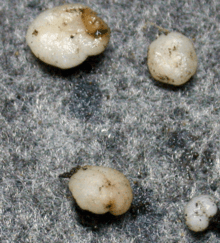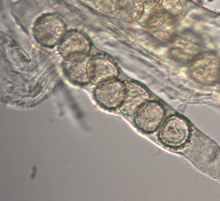Ruhlandiella
Ruhlandiella is a genus of fungi within the family Pezizaceae.[1] Ruhlandiella species are exothecial hypogeous fungi, which are essentially truffles that lack the outer layer or peridium.[2] Ruhlandiella species are widely distributed in Nothofagaceae forests in South America and near Eucalyptus or Melaleuca plants in Australia, North America, and Europe.[3]

| Ruhlandiella | |
|---|---|
| Scientific classification | |
| Kingdom: | |
| Division: | |
| Subdivision: | |
| Class: | |
| Order: | |
| Family: | |
| Genus: | Ruhlandiella Henn. |
| Type species | |
| Ruhlandiella berolinensis Henn. | |
Species
Currently, there are seven accepted species of Ruhlandiella.[3]
- Ruhlandiella berolinensis Henn. 1903
- Ruhlandiella lophozoniae Kraisit., Pfister, Healy & M.E. Sm. 2019
- Ruhlandiella patagonica Kraisit., Pfister, Healy & M.E. Sm. 2019
- Ruhlandiella peregrina Lantieri & Pfister 2011
- Ruhlandiella reticulata (P.H.B. Talbot) E. Rubio, R. Tena, Ormad & A. Suárez 2010
- Ruhlandiella truncata (P.H.B. Talbot) E. Rubio, R. Tena, Ormad & A. Suárez 2010
- Ruhlandiella verrucosa (P.H.B. Talbot) Kraisit., Pfister, Healy & M.E. Sm. 2019
Distribution
Ruhlandiella species have been found several continents across the globe. There are records of Ruhlandiella fungi from Argentina, Australia, Canary Islands, Chile, Italy, and United States (California).[3][4][5] Ruhlandiella patagonica is the most common species in Patagonia, whereas R. lophozoniae is apparently rare.[3] Ruhlandiella berolinensis has been found in Europe and North America. This could be a result of the import of Eucalyptus plants from Australia.[6]
Taxonomy
Ruhlandiella was originally a monotypic genus, first described by Paul Christoph Hennings in 1903 based on a single species: R. berolinensis.[5] His collections were made in a Berlin botanical greenhouse which contained Eucalyptus plants from Australia.[5] In 1989, Warcup and Talbot described a new genus: Muciturbo with 3 species: M. reticulatus, M. truncatus, and M. verrucosus, from New South Wales.[7] However, Rubio et al. (2010) recognized the strong morphological similarities between the two genera, and thus transferred M. reticulatus and M. truncatus to the genus Ruhlandiella, as Ruhlandiella reticulata and Ruhlandiella truncata.[8] Not long after, another species was described from Italy as Ruhlandiella peregrina.[4] Note that all these previous species were described either from Australia or Europe. In 2019, researchers from the University of Florida College of Agricultural and Life Sciences described two more species of Ruhlandiella discovered from deep Patagonian forests in South America (Chile and Argentina). These new species are Ruhlandiella patagonica and Ruhlandiella lophozoniae.[3] Additional taxa, such as Sphaerosoma fuscescens and Boudiera parvispora, were also thought to be Ruhlandiella species.[9][10] Further morphological analysis suggests that these two species do not belong to the genus Ruhlandiella.[3]
Morphology

Ruhlandiella species are characterized by their exothecial ascocarp, highly ornamented ascospores, and paraphyses covered with gelatinous sheathes that greatly exceed asci in length.[5] The color of ascocarp varies ranging from white to brownish lilac, but typically becomes black with age or when exposed.[3] Asci of Ruhlandiella do not contain opercula and range from 180 to 430 µm in length. The ascospores are hyaline, globose, and range from 15 to 39 µm in diameter. The spore ornamentation is reticulate in all species except for R. truncata and R. verrucosa which have truncate ascospores.[7]
Systematics and evolution
The genus Ruhlandiella is a member the family Pezizaceae which includes many genera such as Peziza, Tirmania, and Amylascus.[11] Recent phylogenetic analyses revealed that Ruhlandiella is composed of two biogeographically-defined clades: Australasian and South American.[3] The Australasian clade comprises Ruhlandiella berolinensis, Ruhlandiella reticulata, Ruhlandiella truncata, Ruhlandiella peregrina, and potentially Ruhlandiella verrucosa. The South American clade comprises Ruhlandiella patagonica and Ruhlandiella lophozoniae. It was suggested that the diversification of Ruhlandiella could be a result of the separation of Gondwana, which occurred roughly 135 million years ago.[3][12]
Ecology
Not much is known regarding the ecological roles of Ruhlandiella fungi. From 1990 to 2018, Ruhlandiella species were thought to be ectomycorrhizal fungi, associated only with Eucalyptus, Melaleuca or members of the family Myrtaceae.[13] Recently, researchers have shown that Ruhlandiella patagonica forms ectomycorrhizal association with Lophozonia obliqua and Nothofagus pumilio (Nothofagaceae) and may help with seedling establishment of these trees.[3][14] Furthermore, because the fruiting bodies of R. patagonica look like snail eggs, it has been hypothesized that ground feeding birds might act as long-distance dispersal agents for these truffles.[3]
References
- Lumbsch TH, Huhndorf SM (December 2007). "Outline of Ascomycota – 2007". Myconet. Chicago, USA: The Field Museum, Department of Botany. 13: 1–58.
- Læssøe, Thomas; Hansen, Karen (2007-09-01). "Truffle trouble: what happened to the Tuberales?". Mycological Research. New Bottles for Old Wine. 111 (9): 1075–1099. doi:10.1016/j.mycres.2007.08.004. ISSN 0953-7562. PMID 18022534.
- Kraisitudomsook N., Healy R.A., Mujic A.B., Pfister D.H., Nouhra E.R., and Smith M.E. (2019). "Systematic study of truffles in the genus Ruhlandiella with the description of two new species from Patagonia". Mycologia. doi:10.1080/00275514.2019.1574490.CS1 maint: multiple names: authors list (link)
- Lantieri, Angela; Smith, Matthew E.; Pfister, Donald H. (2012-05-01). "A new species of Ruhlandiella (Pezizaceae) from Italy". Mycological Progress. 11 (2): 509–513. doi:10.1007/s11557-011-0766-x. ISSN 1861-8952.
- Dissing H., Korf R.P. (1980). "Preliminary studies in the genera Ruhlandiella, Sphaerosoma, and Sphaerozone". Mycotaxon. 12: 287–306.
- Vellinga, Else C.; Wolfe, Benjamin E.; Pringle, Anne (2009). "Global patterns of ectomycorrhizal introductions". New Phytologist. 181 (4): 960–973. doi:10.1111/j.1469-8137.2008.02728.x. ISSN 1469-8137. PMID 19170899.
- Warcup J.H., Talbot P.H.B. (1989). "Muciturbo: A new genus of hypogeous ectomycorrhizal Ascomycetes". Mycological Research. 92: 95–100. doi:10.1016/S0953-7562(89)80101-7.
- Rubio E., Tena R., Ormad J., and Suárez A. (2010). "Ruhlandiella reticulata comb. nov. y Ruhlandiella truncata comb. nov. (Ascomycota, pezizales). Nuevas combinaciones para dos raras especies semihipogeas, eucaliptícolas y pirófilas de origen austral: Muciturbo reticulatus y Muciturbo truncatus". Revista Catalana de Micologia. 32: 23–30.CS1 maint: multiple names: authors list (link)
- Rouppert, C. (1909). "Revision du genre Sphaerosoma". Bulletin International de l'Académie des Sciences de Cracovie Classe des Sciences Mathématiques et Naturelles: 75–95.
- Hirsch, G. (1983). "Beiträge zur Kenntnis der Gattung Boudiera Cke. (Pezizales, Ascomycetes) II. Conspectus der Arten". Wissenschaftliche Zeitschrift Mathematisch- Naturwissenschaftliche Reihe. 32: 1013–1024.
- Hansen, Karen; LoBuglio, Katherine F.; Pfister, Donald H. (2005-07-01). "Evolutionary relationships of the cup-fungus genus Peziza and Pezizaceae inferred from multiple nuclear genes: RPB2, β-tubulin, and LSU rDNA". Molecular Phylogenetics and Evolution. 36 (1): 1–23. doi:10.1016/j.ympev.2005.03.010. ISSN 1055-7903. PMID 15904853.
- Ronquist, Fredrik; Sanmartín, Isabel (2004-04-01). "Southern Hemisphere Biogeography Inferred by Event-Based Models: Plant versus Animal Patterns". Systematic Biology. 53 (2): 278–298. doi:10.1080/10635150490423430. ISSN 1063-5157. PMID 15205050.
- Warcup, J.H. (1990). "Occurrence of ectomycorrhizal and saprophytic discomycetes after a wild fire in a eucalypt forest". Mycological Research. 94 (8): 1065–1069. doi:10.1016/S0953-7562(09)81334-8.
- Fernández, Natalia V.; Marchelli, Paula; Fontenla, Sonia B. (2013-10-01). "Ectomycorrhizas Naturally Established in Nothofagus nervosa Seedlings Under Different Cultivation Practices in a Forest Nursery". Microbial Ecology. 66 (3): 581–592. doi:10.1007/s00248-013-0229-9. ISSN 1432-184X. PMID 23636582.